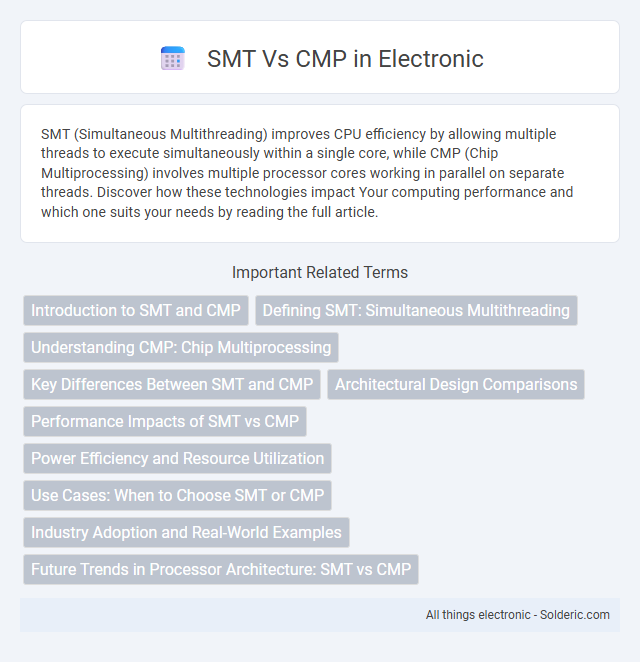SMT (Simultaneous Multithreading) improves CPU efficiency by allowing multiple threads to execute simultaneously within a single core, while CMP (Chip Multiprocessing) involves multiple processor cores working in parallel on separate threads. Discover how these technologies impact Your computing performance and which one suits your needs by reading the full article.
Comparison Table
| Feature | SMT (Simultaneous Multithreading) | CMP (Chip Multiprocessing) |
|---|---|---|
| Definition | Multiple threads executed concurrently within a single CPU core | Multiple CPU cores integrated on a single chip |
| Execution Units | Shared among threads in one core | Each core has dedicated execution units |
| Parallelism Type | Thread-level parallelism within one core | Core-level parallelism across multiple cores |
| Performance | Improves utilization of core resources, moderate boost | Significant increase via multiple cores running in parallel |
| Power Consumption | Relatively low, as it uses single core resources | Higher power due to multiple cores |
| Complexity | Requires advanced scheduling and resource sharing | Requires multicore coordination and cache coherence |
| Example | Intel Hyper-Threading Technology | AMD Ryzen, Intel Core i7 multicore CPUs |
Introduction to SMT and CMP
Surface-Mount Technology (SMT) involves placing electronic components directly onto the surface of printed circuit boards (PCBs), enabling high-density, automated assembly with improved electrical performance. Chip Manufacturing Process (CMP) refers to the advanced polishing technique used in semiconductor fabrication to create flat, defect-free wafer surfaces essential for subsequent lithography steps. Understanding SMT's assembly efficiency and CMP's wafer planarization is crucial in modern electronics manufacturing.
Defining SMT: Simultaneous Multithreading
Simultaneous Multithreading (SMT) enhances processor efficiency by allowing multiple independent threads to issue instructions to a single core simultaneously, increasing utilization of execution units. Unlike Chip Multiprocessing (CMP), where multiple cores run separate threads in parallel, SMT shares core resources dynamically, optimizing throughput within one physical CPU core. Understanding how SMT manages thread-level parallelism can help you improve performance in workloads with high instruction-level concurrency.
Understanding CMP: Chip Multiprocessing
Chip Multiprocessing (CMP) enhances computing performance by integrating multiple processor cores on a single chip, enabling parallel task execution and improved efficiency. Unlike Simultaneous Multithreading (SMT), which allows a single core to run multiple threads, CMP provides distinct physical cores that handle separate processes, reducing resource contention. Understanding CMP helps you optimize system architecture for workloads requiring high scalability and power efficiency.
Key Differences Between SMT and CMP
Simultaneous Multithreading (SMT) exploits thread-level parallelism by allowing multiple threads to issue instructions in a single CPU core during the same clock cycle, improving processor utilization and throughput. Chip Multiprocessing (CMP), on the other hand, integrates multiple independent cores on a single chip, enabling parallel execution of separate threads or processes across cores, significantly enhancing multi-threaded performance and scalability. Understanding these key differences helps you optimize system architecture choices based on workload characteristics and performance requirements.
Architectural Design Comparisons
SMT (Simultaneous Multithreading) improves processor efficiency by allowing multiple threads to share a single core's execution units, optimizing resource utilization within the architectural pipeline. CMP (Chip Multiprocessing) involves integrating multiple independent cores on a single chip, enabling true parallelism by running separate threads or processes simultaneously. Your choice depends on whether you prioritize enhancing single-core throughput with SMT or increasing overall computational power through CMP's multicore architecture.
Performance Impacts of SMT vs CMP
Simultaneous Multithreading (SMT) enhances processor efficiency by allowing multiple threads to share a single core's resources, improving throughput without significantly increasing power consumption. Chip Multiprocessing (CMP) involves multiple cores on a single chip, delivering superior parallel processing capabilities and better isolation between threads, which often results in higher overall performance for multi-threaded applications. Choosing between SMT and CMP depends on your workload's concurrency demands and whether maximizing single-thread performance or parallel scalability is more critical.
Power Efficiency and Resource Utilization
Simultaneous Multithreading (SMT) enhances power efficiency by maximizing core utilization through concurrent thread execution, reducing idle cycles compared to Chip Multiprocessing (CMP), which relies on multiple cores that may remain underutilized under low thread workloads. CMP provides better resource isolation and scalability for parallel tasks but can lead to higher overall power consumption due to duplicated core resources. Optimizing your computing environment with SMT can improve power efficiency and resource utilization by leveraging shared execution units within a single core.
Use Cases: When to Choose SMT or CMP
SMT (Simultaneous Multithreading) is ideal for improving the efficiency of CPU cores in handling multiple threads in parallel, making it suitable for general-purpose computing and workloads with diverse, concurrent tasks. CMP (Chip Multithreading), or multicore processors, excels in scenarios requiring high processing power through physical cores, such as gaming, scientific simulations, and server environments demanding heavy parallel processing. Choose SMT to maximize throughput within a single core for mixed workloads, while CMP is preferable for sustained, resource-intensive applications needing robust multi-core performance.
Industry Adoption and Real-World Examples
Surface Mount Technology (SMT) dominates the electronics manufacturing industry due to its efficiency in placing small components on printed circuit boards, widely adopted in consumer electronics like smartphones and laptops. Chemical Mechanical Planarization (CMP) is primarily utilized in semiconductor fabrication, enabling wafer surface planarization essential for integrated circuit production in companies such as Intel and TSMC. Understanding these technologies helps your business choose suitable processes for prototyping or mass production in the electronics and semiconductor sectors.
Future Trends in Processor Architecture: SMT vs CMP
Future trends in processor architecture emphasize the integration of Simultaneous Multithreading (SMT) and Chip Multiprocessing (CMP) to enhance parallelism and performance efficiency. SMT maximizes the utilization of a single core's execution resources by allowing multiple threads to run concurrently, while CMP increases overall throughput by incorporating multiple cores on a single chip. Emerging designs increasingly combine SMT and CMP techniques to optimize workload distribution and power consumption, addressing the growing demands of cloud computing, AI, and high-performance computing applications.
SMT vs CMP Infographic

 solderic.com
solderic.com